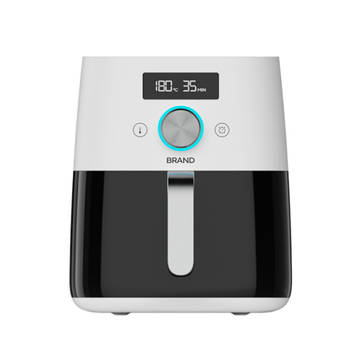At the heart of an air fryer is its ability to generate and circulate superheated air at high velocity. The unit typically houses a powerful heating element positioned near the top of the chamber, which rapidly raises the internal temperature. A high-capacity fan, located just above or behind the heating coil, then forces this hot air around the food in a tightly controlled, circular motion. This rapid air circulation—known in technical terms as a Rapid Air Technology System—mimics the immersion-style cooking environment of a deep fryer by evenly exposing all surfaces of the food to high heat. Unlike traditional ovens, the compact cooking chamber of an air fryer ensures that heat is concentrated, accelerating cooking times and enhancing surface crisping without oil saturation.
The signature golden-brown color and crunchy texture associated with fried foods result from a process called the Maillard reaction. This chemical reaction occurs when amino acids and reducing sugars on the food’s surface interact under high temperatures—generally between 280°F (140°C) and 330°F (165°C). In deep frying, this is facilitated by hot oil enveloping the food. In an air fryer, the same reaction is achieved through the rapid and sustained exposure of the food’s exterior to hot air, typically ranging from 350°F to 400°F (180°C to 200°C). The air fryer’s dry heat environment allows moisture to escape quickly while triggering the Maillard process, leading to the development of complex flavor compounds and a crisp outer layer—all without oil submersion.
Although oil is not essential in air frying, a small amount—usually between 1 to 2 teaspoons—applied directly to the food surface can significantly enhance results. This light oil coating helps promote even browning, encourages heat conduction on the surface, and improves adhesion of dry rubs or breading. By contrast, deep fryers require full immersion in oil, often absorbing a substantial amount of fat into the food’s interior. Air fryers avoid this by limiting oil to the surface level, allowing users to achieve a satisfying crispness with far fewer calories and significantly less fat content. From a nutritional standpoint, this difference is substantial and appeals to users seeking healthier cooking methods without compromising texture.
The internal layout of an air fryer is specifically engineered to optimize airflow. Most models feature a perforated cooking basket or mesh tray that elevates the food and permits hot air to flow underneath, above, and around it. This 360-degree heat exposure is essential for uniform cooking and crisping. By ensuring that moisture is wicked away quickly and not trapped underneath the food (as it might be in a pan or on a baking sheet), the design minimizes the risk of sogginess and enhances crunch. The compact space further intensifies airflow concentration, contributing to consistent texture on all sides without requiring flipping or repositioning.
Deep frying achieves crispness by surrounding food in oil, which rapidly transfers heat and produces a sealed, crunchy crust. However, this method also causes oil to penetrate the food, especially when the crust is breached or during cooling. Air frying, in contrast, uses dry, circulating air to achieve a similar external crunch without soaking the food. This is done by quickly dehydrating the surface of the food while cooking the interior to the desired doneness. The air fryer’s design accelerates moisture evaporation, a key factor in surface crisping. Because air is a less efficient heat conductor than oil, air fryers compensate by increasing both airspeed and temperature—thus achieving similar textures without oil saturation.


 English
English 中文简体
中文简体 English
English 中文简体
中文简体
















